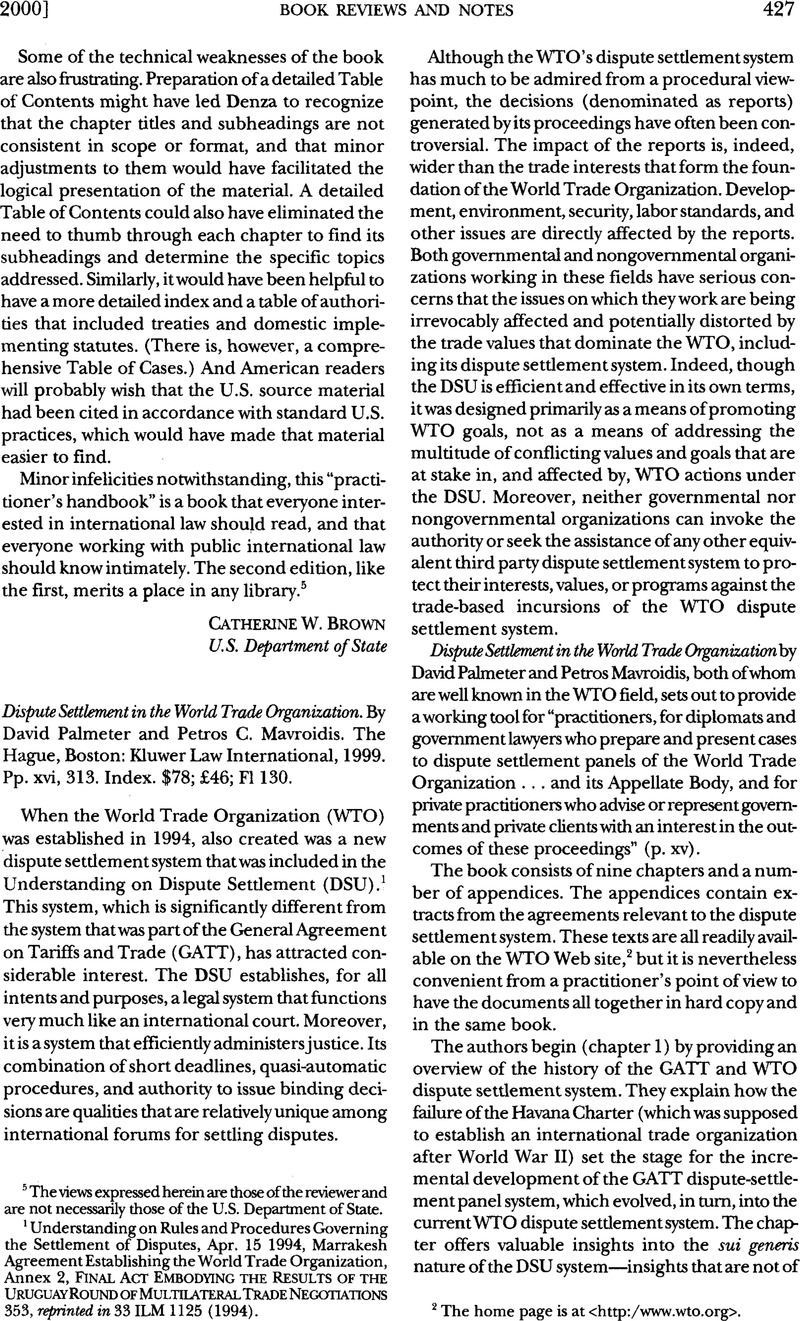Published online by Cambridge University Press: 27 February 2017

1 Understanding on Rules and Procedures Governing the Settlement of Disputes, Apr. 15 1994, Marrakesh Agreement Establishing the World Trade Organization, Annex 2, Final Act Embodying the Results of the Uruguayround of Multilateral Trade Negotiations 353, reprintedin 33 ILM 1125 (1994).
2 The home page is at <>.
3 WT/DS58/R, para. 7.8 (May 15, 1998).
4 WTO Appellate Body, United States—Import Prohibition of Certain Shrimp and Shrimp Products, Oct. 12, 1998, WTO Doc. WT/DS58/AB/R, para. 110. See also Kim Van der Borght, The Review of the WTO Understanding on Dispute Settlement: Some Reflections on the Current Debate, 14 am. U. Int’l L. Rev. 1229 (1999).
5 Chapter 3 was published earlier in this Journal: David Palmeter and Petros C. Mavroidis, The WTO Legal System: Sources of Law, 92 AJIL 398 (1998).
6 See, e.g., Ernst-Ulrich Petersmann, Violation-Complaints and Non-violation Complaints in Public International Trade Law, 34 German Y.B. Int’l L. 175 (1991); Sung-joon Cho, Non-violation Issues in the WTO Framework: Are they the Achilles’ Heel of the Dispute Settlement Process?, 39 Harv. Int’l L.J. 311 (1998); Adrian T. L. Chua, Reasonable Expectations and Non-violation Complaints in GATT/WTO Jurisprudence, J. World Trade, Apr. 1998, at 27.
7 See, e.g., Kofi Oteng Kofuor, From the GATT to the WTO—The Developing Countries and the Reform of the Procedures for the Settlement of International Trade Disputes, J. World Trade, Oct. 1997, at 117.
8 Agreement on Sanitary and Phytosanitary Measures, Apr. 15, 1994, Marrakesh Agreement Establishing the World Trade Organization, Annex 1A, The Results of the Uruguay Round of Multilateral Trade Negotiations: The Legal Texts 69 (1994) [hereinafter Results].
9 Agreement on Technical Barriers to Trade, Apr. 15, 1994, Marrakesh Agreement Establishing the World Trade Organization, Annex 1A, Results, supra note 8, at 138.
10 Agreement on Textiles and Clothing, Apr. 15, 1994, Marrakesh Agreement Establishing the World Trade Organization, Annex 1A, Results, supra note 8, at 85.
11 Agreement on Government Procurement, Apr. 15, 1994, Marrakesh Agreement Establishing the World Trade Organization, Annex 4.
12 Agreement on Trade in Civil Aircraft, Apr. 12, 1979, BISD 26S/162.
13 Shabtai Rosenne, The International Court of Justice 56 (1957).
14 Id. at 57.
15 On the developing jurisprudence from GATT to WTO, see generally Adrian Chua, The Precedential Effects of WTO Panel and Appellate Body Reports, 11 Leiden J. Int’l L. 45 (1998); Philip M. Nichols, GATT Doctrine, 36 Virginia J. Int’l L. 380 (1996); Robert E. Hudec, The Judicialization of GATT Dispute Settlement, in In Whose Interest? (Michael M. Hart & Debra P. Steger eds.) (proceedings of a conference held at the University of Ottawa, Faculty of Law, May 3, 1990).
16 The system used is called inverted, negative, or reversed consensus: in order to reject a report of a panel or of the Appellate Body, all DSB members of the DSB (including those who agree with, and have an interest in, its findings) have to agree.
17 See European Communities, Discussion Paper on the Review of the Dispute Settlement Understanding (DSU) (1999), available in <http://www.lancs.ac.uk/users/law/indaw/ibuslaw/docs/wt-eu-dsrev.htm>.